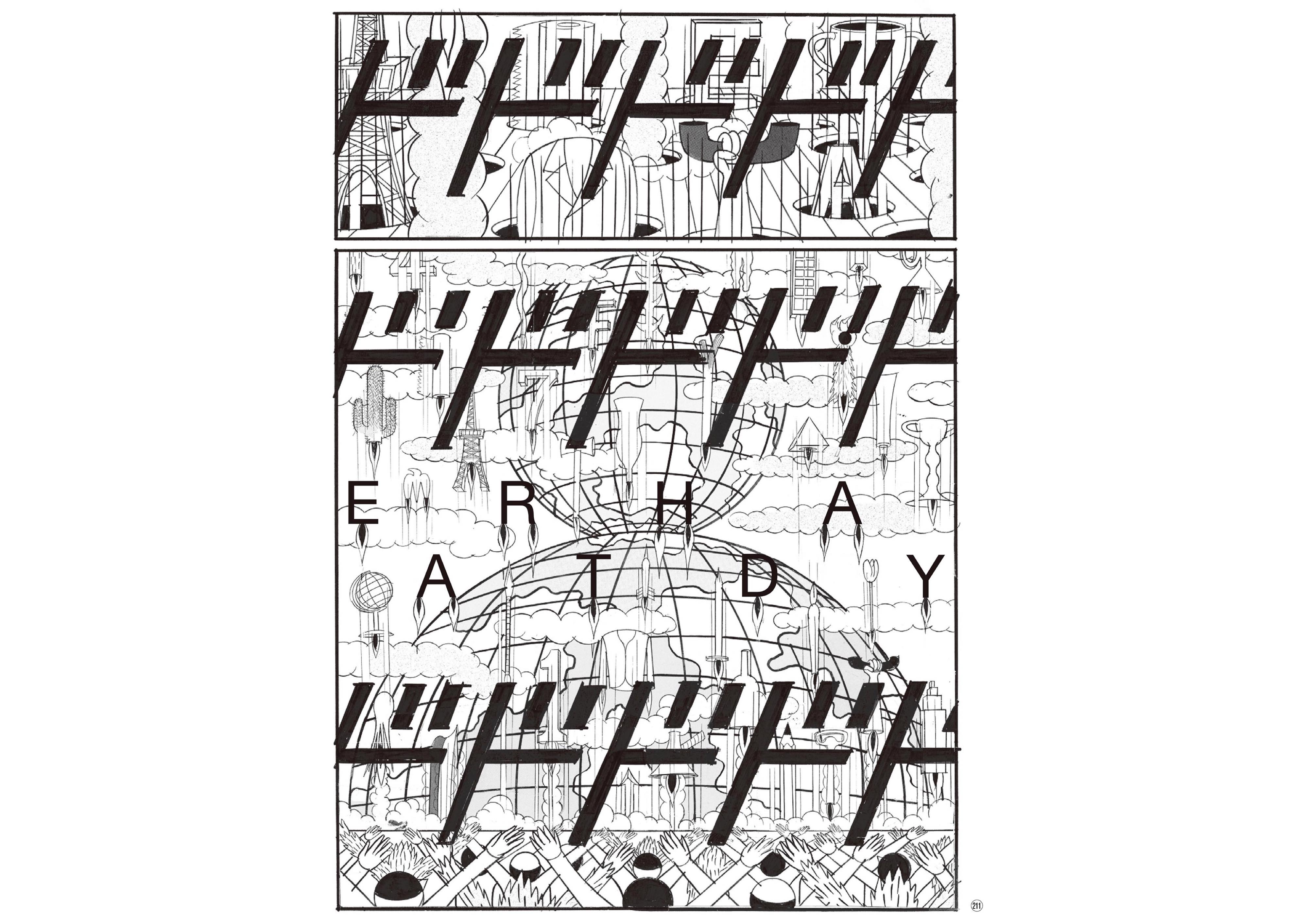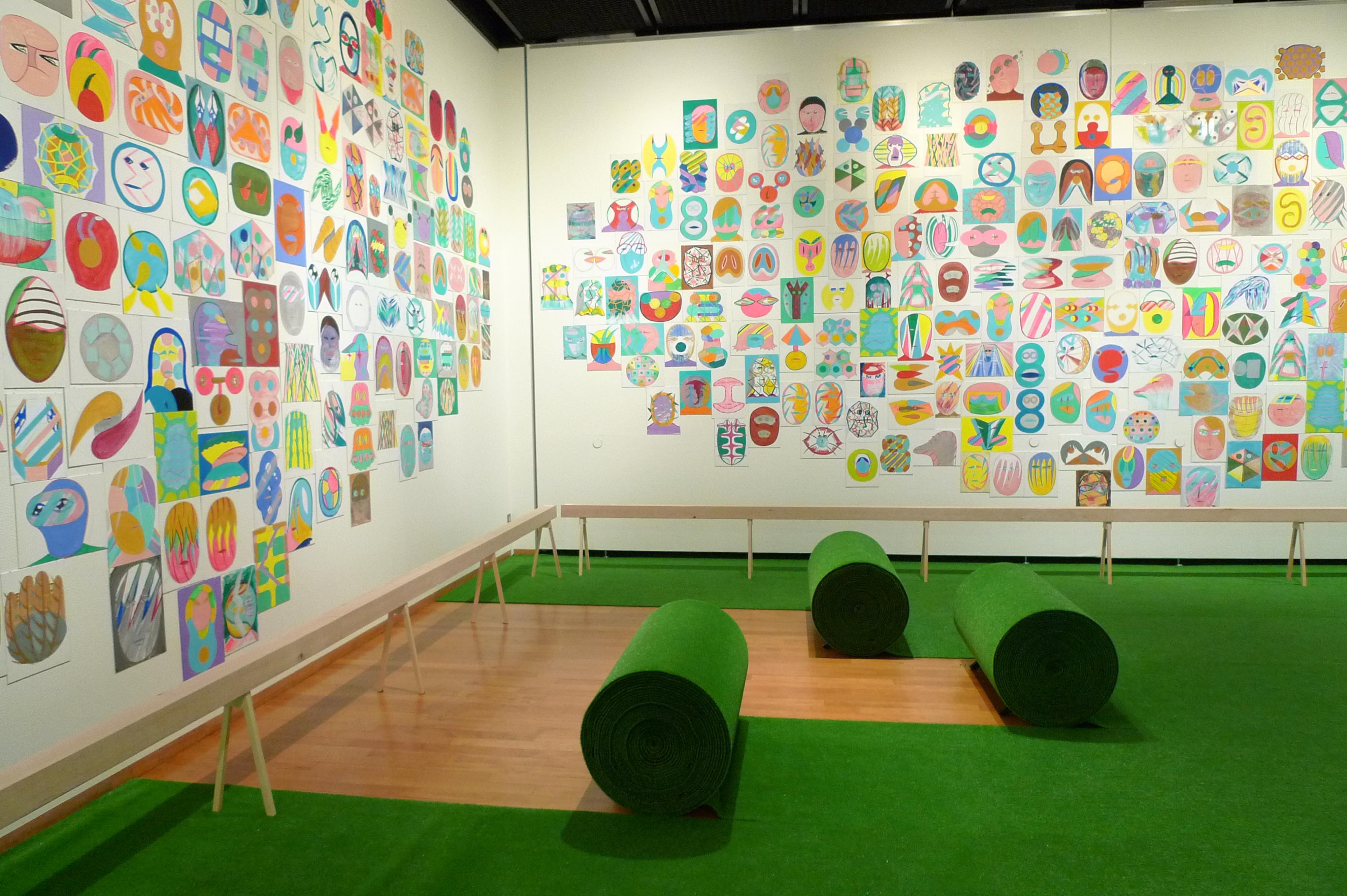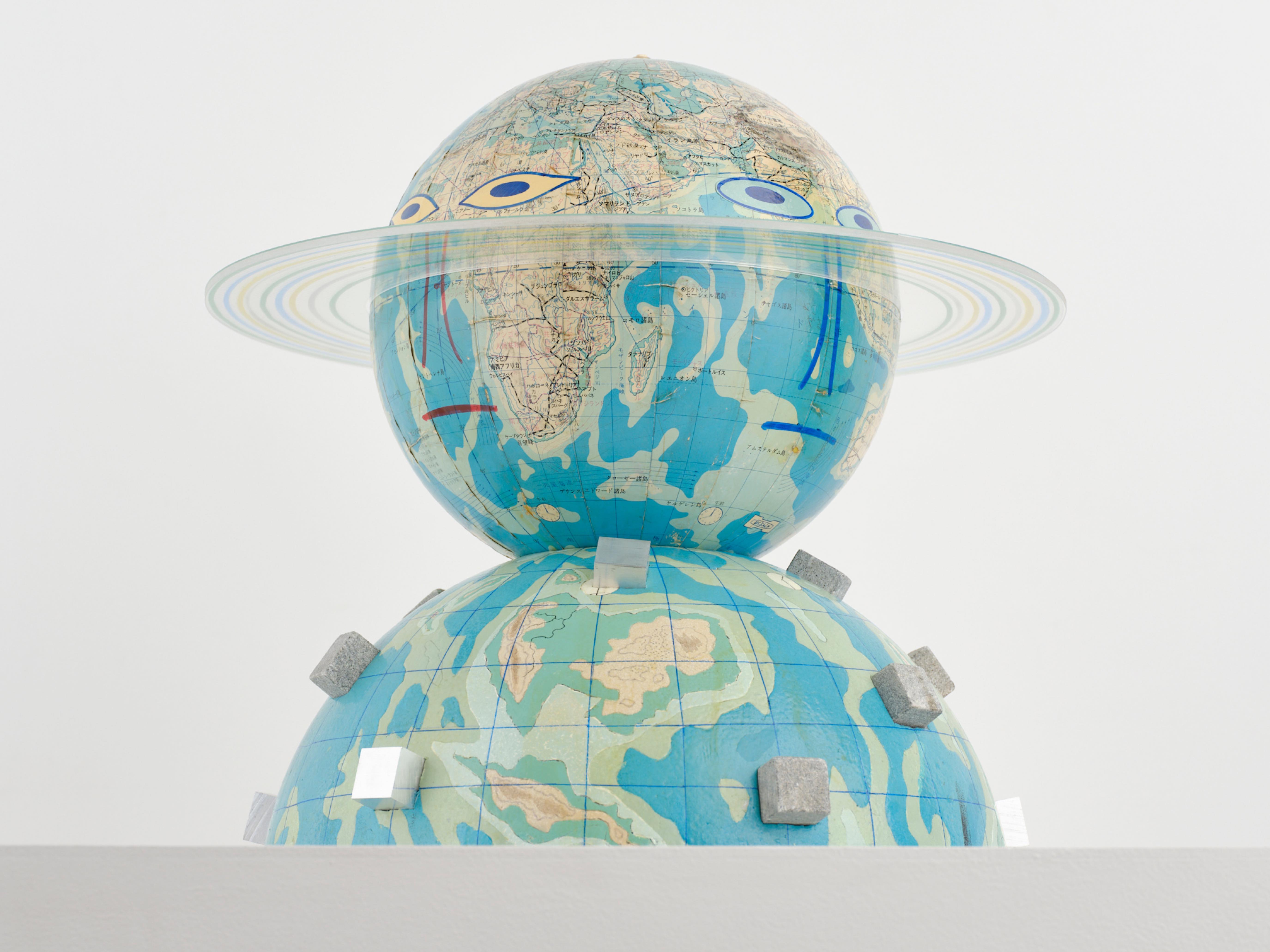
Yuichi Yokoyama
Solo Exhibition
EARTH DAY
2024.1.27 (Sat.) - 2024.2.24 (Sat.)
*Due to its popularity, the exhibition will also be open on 2.23 (Fri., National Holiday)
Opening reception with the artist: 1.27 (Sat.) 17:00 – 19:00
Talk Event: 2.17 (Sat.) 17:00 – 18:30
Speakers: Yuichi Yokoyama, Kodama Kanazawa (Curator of contemporary art)
For more information, please click here.
We are pleased to announce the upcoming solo exhibition by Yuichi Yokoyama titled EARTH DAY at ANOMALY. The exhibition will run from January 27 (Sat.) to February 24 (Sat.), 2024.
 Zen Temple (2018) Acrylic and marker on fusuma, H182xW289cm ©︎Yuichi Yokoyama
Zen Temple (2018) Acrylic and marker on fusuma, H182xW289cm ©︎Yuichi Yokoyama
Born in Miyazaki Prefecture in 1967, Yuichi Yokoyama graduated from Musashino Art University with a degree in oil painting. After his graduation, he embarked on a search for his own style of expression in painting while producing pictures of landscapes and people painted on plywood. Beginning around 2000, he widened the scope of his art to manga, which enabled him to “draw time,” and made his debut as manga artist with the publication of New Engineering in paperback form in 2004.
Yokoyama’s distinctive style characterized by dashing lines, onomatopoeias, and characters crossing borders of gender and nationality has been termed “neo-manga” and is roundly applauded both inside and outside Japan.
So far, he has produced numerous books including PLAZA, Burning Sound, Room, ICELAND, The Room of the World Map, Baby Boom, Outdoors, Garden, and Travel. Many of them have been published in translation in countries such as France, the United States, Italy, Spain, and Russia.
 Figure ①: PLAZA (2019) 888books, p.211 ©︎Yuichi Yokoyama
Figure ①: PLAZA (2019) 888books, p.211 ©︎Yuichi Yokoyama
Last year saw the publication of Neo Manyo, whose production actually took about nine years from conception to completion. It consists of 22 stories reconstructed on the basis of 173 waka poems from sources including Manyoshu (Collection of a Myriad Leaves) and Kokin Wakashu (Collection of Ancient and Modern Poetry). Brilliantly fusing the rhythm of onomatopoeias and waka poems, this book attracted considerable attention for its presentation of a new outlook on classical Japanese poetry.
Yokoyama’s genre-spanning expression is also coming to the fore in the sphere of comtemporary art. Besides holding big solo exhibitions in Japan and other countries, as exemplified by “Roppongi Crossing 2007” Mori Art Museum, Tokyo, Japan (2007); “Aichi Triennale 2013” Aichi, Japan (2013); “Logical Emotion”, Museum Haus Konstruktiv, Zurich, Switzerland (2014) / Museum of Contemporary Art in Krakow (MOCAK), Krakow, Poland (2015) / Kunstmuseum Moritzburg Halle (Saale), Land Sachsen-Anhalt, Germany (2015); “Tiger Tateishi & Yuichi Yokoyama” Hiroshima City Museum of Contemporary Art, Hiroshima, Japan (2016); “CHILDHOOD: Another Banana Day For The Dream-Fish” Palais de Tokyo, Paris, France (2018). He has participated in many international exhibitions and group shows, including “Yuichi Yokoyama – I am depicting time: Complete Records of Neo Manga” Kawasaki City Museum, Kanagawa, Japan (2010); “YÛICHI YOKOYAMA: WANDERING THROUGH MAPS, UN VOYAGE À TRAVERS LES CARTES”, Pavillon Blanc, Colomiers, France (2014).
In 2021, a pictorial work of his that is eight meters high was permanently installed on Tokiwabashi Tower.
 “Yuichi Yokoyama – I am depicting time: Complete Records of Neo Manga” Installation view, Kawasaki City Museum, Kanagawa, Japan, 2010
“Yuichi Yokoyama – I am depicting time: Complete Records of Neo Manga” Installation view, Kawasaki City Museum, Kanagawa, Japan, 2010
Yokoyama’s manga works do not have a clear-cut story line. They depict the nonsensical conversation, and both hostile and apparently purposeless behavior, of characters transcending gender, age, nationality, and the times, along with mysterious objects that move and undergo metamorphosis. As they unroll in succession with just the right frame size and density, these depictions portray a world out of our experience that could be either in the past or the future, together with a pure flow of time. Simultaneously, they seem to be observing and recording this world from the overhead perspective of a non-human creature living in a different time and place from us. The ethics and standards shaped by the times and society; the life environment based on them; behavior, emotions, gender, and occupation; even the very idea of time—they all no longer make sense.
Furthermore, the onomatopoeias for action and clamor such as “dodododo,” “wah-wah,” and “gooooo” are boldly and repeatedly deployed, and generate a continuous noise in the vision of the viewer. At times, they may give us the sensation of excitement and absorption of the sort that could cause us to lose all sense of space and time, as can occur during repeated exposure to harsh noise*¹⁾.
From the panel paintings Yokoyama made from the 1990s to the mid-2000s and the paintings made with screen tone in parallel with his manga as well, one can discern an overhead line of sight that is shared with his manga style.
His Ourselves series is comprised of an enormous number of paintings on canvas boards that look like pictures of specimens of human faces.
 Three People (ourselves) (2013) Screentone on Paper, H36xW46.5cm ©︎Yuichi Yokoyama
Three People (ourselves) (2013) Screentone on Paper, H36xW46.5cm ©︎Yuichi Yokoyama
In contrast to the continuous development that knows no end in his manga works, the world of Yokoyama’s painted works is at rest in a temporal and spatial crevice that has fallen out of the flow of time. These disquieting canvases, whose aftertones seem to go on forever, like droning sounds, present us with invitations to narratives that are not clearly identified and frames in which some huge mystery lurks.
 Tanker and Skyscraper (1992) Paint, marker and varnish on board, H180.4xW274.5cm ©︎Yuichi Yokoyama
Tanker and Skyscraper (1992) Paint, marker and varnish on board, H180.4xW274.5cm ©︎Yuichi Yokoyama
This exhibition will display Cooperation (2023), one of Yokoyama’s latest paintings, and 3D works from the EARTH DAY series (2023). In addition, it will show for the first time in eastern Japan a fusuma-e (picture on a sliding screen) titled Zen Temple, as well as major works from the past (paintings, drawings, original manga pictures, etc.).
The exhibition title EARTH DAY is also the title of one of my latest works. This work remakes the personified globe (see Figure 1) that appears on page 211 of PLAZA, a paperback of mine published in 2019, into an extremely unusual 3D object that I created. This earth has rings like Saturn that can be replaced with others of different colors. I may change the colors during the run of the exhibition (or may not). Although I did not do this in the manga version, I drew faces on each of the four sides (north, south, east, and west) to make an Ashura statue for our age. Earth Day was originally a day to commemorate the earth, but I have no idea where it came from and what we are supposed to do on it. Aside from this work, the exhibit will also display a never-before-shown painting of spectacular scenery on a magnificent other world (it is huge).
– Yuichi Yokoyama –
 EARTH DAY ① (2023) Plastic, styrofoam, acrylic, marker and stone, H34.8xφ35cm ©︎Yuichi Yokoyama
EARTH DAY ① (2023) Plastic, styrofoam, acrylic, marker and stone, H34.8xφ35cm ©︎Yuichi Yokoyama
Photo by Ichiro Mishima
Through the world of Yokoyama’s works, we can take another, closer look at our world while letting our imagination play over the diverse perspectives and temporal possibilities. This too undoubtedly constitutes another type of Earth Day.
This long-awaited solo exhibition of works by Yuichi Yokoyama is his first in about ten years.
We earnestly hope you will come and see it!
On February 17 (Sat.), during the second half of the exhibition’s run, we are going to hold a talk event with the curator Kodama Kanazawa, who planned the exhibition Yuichi Yokoyama Neo-Manga Archive: I am Drawing Time (held at the Kawasaki City Museum in 2010). For details, please access the websites of ArtSticker and ANOMALY as well as social media.
During the run of the exhibition, we are also planning to publish EARTH DAY, a collection of Yokoyama’s works featuring the latest ones, with a critical review by Kodama Kanazawa at the end. Please look forward to it!
ANOMALY
January 2024
Notes:
*¹⁾ Tremendous bombastic noise originating from a piece of metal, synthesiser or mixer feedback, and others; which is amplified and modulated by a guitar pedal, mixer or amplifier. Representative Japanese artists include Merzbau and INCAPACITANTS.
Reference:
Naoko Sumi (2016) ‘Welcome to the Strange World!’ THE WORLD IS STRANGE! THE MANGA AND PAINTINGS OF TIGER TATEISH AND YUICHI YOKOYAMA, Hiroshima City Museum of Contemporary Art, p.65
Yu Ito (2016) ‘Manga expression in the works of Tiger Tateishi and Yuichi Yokoyama: Symbols, panels, and Fujio Akatsuka’ THE WORLD IS STRANGE! THE MANGA AND PAINTINGS OF TIGER TATEISH AND YUICHI YOKOYAMA, Hiroshima City Museum of Contemporary Art, p.69
Mizuki Takezaki (2021) ‘Encounter, Repeatedly’ Encounter — Infinite Variety of Faces Exhibition Catalogue [Vol.2], Marugame Genichiro-Inokuma Museum of Contemporary Art, The MIMOCA Foundation, p.40-45









